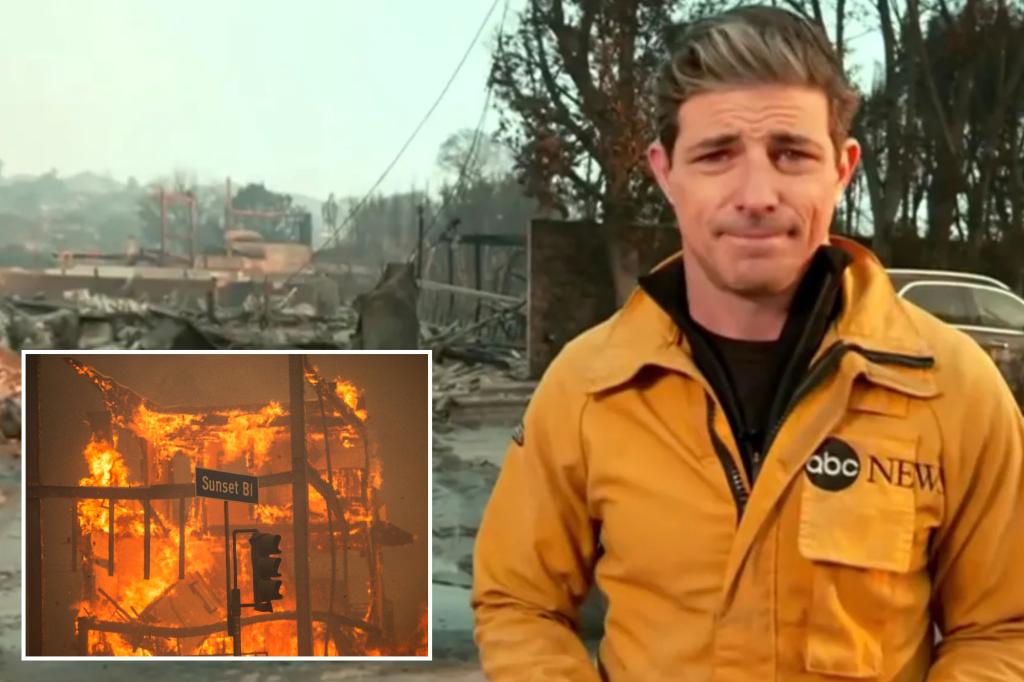The devastating Palisades Fire, one of several wildfires plaguing Southern California, tore through the Pacific Palisades neighborhood of Los Angeles, leaving a trail of destruction and displacing numerous residents. ABC News chief national correspondent Matt Gutman reported live from the scene, providing a poignant and personal account of the fire’s impact, as his own aunt’s home was among those consumed by the flames. Gutman, standing amidst the charred remains of what were once vibrant homes, described the scene as gut-wrenching, with the heat still radiating from the rubble. He highlighted the widespread devastation, noting that he knew multiple individuals who had lost their homes in the inferno. The emotional toll on his aunt, who fortunately was out of town at the time, was evident, though Gutman shared that her primary relief stemmed from the fact that no lives were lost. This sentiment of gratitude for the preservation of life echoed throughout the community, amidst the palpable grief over the loss of property and memories.
The fire’s rapid spread and intensity shocked residents and authorities alike. Gutman attributed the ferocity of the blaze to a confluence of factors, including the dry season, dense vegetation, and what he termed the “most ferocious wind event in 15 years.” This “perfect storm” of conditions created an environment ripe for rapid fire spread, turning the normally picturesque landscape into a tinderbox. The fire’s path carved a swathe of destruction through the area, leaving behind a surreal panorama of charred homes and debris. Gutman described the chilling sight of a three-story condominium reduced to a pile of rubble, with recognizable household items like kitchen appliances and bathtubs scattered amidst the devastation, a grim testament to the fire’s indiscriminate power. The scale of the destruction underscored the vulnerability of even densely populated areas to the unpredictable fury of wildfires.
Gutman’s personal connection to the tragedy added an extra layer of poignancy to his reporting. He revealed that his own family home had been threatened by a separate fire that came within 300 yards before being extinguished. The experience instilled a sense of urgency and fear in his family, prompting him to prepare a “go bag” filled with essential items in case of evacuation, a precaution he advised other residents to take. This personal experience mirrored the anxiety felt by countless Angelenos as they watched the fire’s progress with apprehension, unsure whether their homes would be next. The incident served as a stark reminder of the ever-present threat of wildfires in the region and the importance of preparedness.
The Palisades Fire, one of five active wildfires in Southern California at the time, consumed nearly 20,000 acres and was only six percent contained at the time of Gutman’s report. The scale of the disaster highlighted the immense challenge faced by firefighters battling the blaze. The combined impact of multiple simultaneous wildfires stretched resources thin and underscored the need for coordinated efforts to combat the widespread threat. The fires served as a sobering reminder of the increasing frequency and intensity of wildfires in the region, likely exacerbated by climate change and prolonged periods of drought.
The human cost of the fires, while thankfully limited in terms of fatalities, remained significant. Two deaths were confirmed in the Palisades Fire, and at least five others perished in the Eaton Fire, another major conflagration in the region. These losses brought the gravity of the situation into sharp focus, underscoring the dangers posed by such rapidly spreading infernos. While the focus remained on containing the fires and protecting lives and property, the emotional scars left by the disaster would undoubtedly linger long after the flames were extinguished. The sense of vulnerability and the stark images of destruction would serve as a constant reminder of the precarious balance between human habitation and the unpredictable power of nature.
Beyond the immediate loss of life, the fires’ devastating impact extended to the destruction of over 10,000 structures, including the homes of many celebrities. The widespread loss of property represented a significant economic blow to the region and highlighted the long road to recovery that lay ahead for those affected. The fires forced residents to confront the stark reality of losing their homes and possessions, disrupting lives and leaving many with an uncertain future. The rebuilding process promised to be lengthy and arduous, requiring significant resources and community support. The fires’ aftermath would serve as a testament to the resilience of the human spirit and the importance of collective action in the face of adversity.

